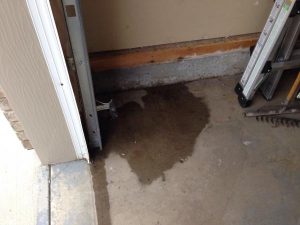By waterproofing garage doors, you actually invest in ways of protecting your valuables and saving money in the long run. It’s a way of weatherproofing garage doors, except here your intention is to keep waters out. So, let us take a closer look at the relative concerns and what you need to do to waterproof your garage door.
What is garage door waterproofing?
Garage door waterproofing is the method that allows you to seal the material so that it will remain resistant to rain and humidity. That’s important especially for wood garage doors since natural timber is highly susceptible to water and thus unsuitable for wet environments and regions prone to storms and hurricanes. When it comes to floods created by storms, the truth is that all garage doors would remain far more resistant when waterproofed.
Waterproofing garage doors: Why is it important?
Let us assume that a storm caused floods or rivers to overflow and flood the streets. This has happened before and is highly likely to happen in the future too. The results to your garage door? Catastrophic. What the winds left standing, the water will finish off. Even if the storm didn’t take a toll on your overhead door, the water will.
streets. This has happened before and is highly likely to happen in the future too. The results to your garage door? Catastrophic. What the winds left standing, the water will finish off. Even if the storm didn’t take a toll on your overhead door, the water will.
But your waterproofed residential garage doors will not only be protected by water but the sun too. The sealants applied on the door do their magic. They act as protective layers and thus keep the sunrays from causing havoc. And so you have a dual benefit: you ensure the integrity of the garage door and the curb appeal of your home exterior.
It’s vital to remember that water and moisture trapped inside the garage will create mold which will ruin your valuables and cause health issues.
When should you waterproof garage doors?
It’s important to waterproof garage doors when they are not sealed or pre-stained or pre-painted to resist water. Some steel garage doors come pre-painted to remain resistant. From another angle, it’s also crucial to waterproof when your region is prone to wet weather, floods, and storms.
In such cases, garage door weatherproofing is also important. When the weather is not your door’s friend, it’s important to take measures. Whether you are afraid of the rainwater or the cold weather that will arrive along with rainfall, you should invest in stainless steel garage door tracks, nylon rollers, and resistant parts that won’t be affected by the weather. It’s important to lube springs to keep them flexible and seal the four sides of the door to keep drafts and rainwater out. Be sure to check the bottom seal often.
weather is not your door’s friend, it’s important to take measures. Whether you are afraid of the rainwater or the cold weather that will arrive along with rainfall, you should invest in stainless steel garage door tracks, nylon rollers, and resistant parts that won’t be affected by the weather. It’s important to lube springs to keep them flexible and seal the four sides of the door to keep drafts and rainwater out. Be sure to check the bottom seal often.
Run a small test. Turn on the exterior lights and go in the garage. If you can see the lights under the door, this is bad news and calls for garage door bottom seal replacement. Don’t forget that a small gap under the door will enable water ingress.
How to waterproof the garage door
Naturally, waterproofing garage doors means applying a sealant or special stain on the surface. A wooden garage door can be easily waterproofed with a stain that penetrates its pores. Prefer back brushing as the best method for better absorption of the stain compared to using rollers or sprayers. The harder part during the process is before. You need to clean the door very well making sure the dirt, grime, and dust are all removed entirely before you apply the sealants or stains. If there is a glaze, you need to sand the material too.
Waterproof and weatherproof garage doors but also check that water doesn’t find another way in. For example, check the external area around the garage. If you have two single garage doors, the central pillar might have some cracks. You need to repair any crack that will allow water to sit in and eventually to pour indoors or cause foundation damage.
Other methods of waterproofing the area around the garage is installing a drainage system in front of the door or flood vents. Indoors, you can apply epoxy or tanking slurry on the walls and floor to waterproof them too.






